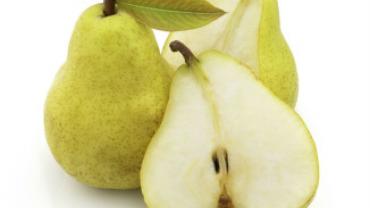
Apples tend to come to mind first when we think of fall fruit thanks to orchards offering “pick your own” days and hot apple cider spiced cider donuts and other warm apple treats gracing restaurant menus and curbside food trucks. But apples aren’t the only game in town when the days get shorter and a chill comes into the air. You know it’s autumn when pyramids of pears appear at grocery stores and farmers’ markets.
Fruit is getting a bad rap in some nutrition circles. It is “nature’s candy” and aside from honey fruits are the sweetest-tasting whole unprocessed foods available. And even though this is of course natural sugar it’s still sugar and high consumption of fruit may not be suitable for some individuals depending on their individual metabolic state and health goals. Owing to its fructose content fruit was long considered a “safe” food for diabetics. This is because fructose does not have a significant impact on blood glucose; however due to the obligate metabolism of fructose in the liver heavy consumption of fruits that are relatively high in fructose (such as grapes) may exacerbate non-alcoholic fatty liver and pathological insulin resistance.
A small pear (about 150g) provides less than 90 calories almost all of which is carbohydrate. Of the 23g total carbohydrate approximately 1g is sucrose 4g are glucose over 9g are fructose and 5g are fiber. The glycemic load is miniscule at a rating of just 5. This would make pears seem like an ideal choice for those struggling with blood glucose management but being that the low glycemic impact is due to the predominance of fructose over glucose a patient’s total state of health should be considered when healthcare professionals make recommendations regarding fruit consumption.
To be realistic though if a patient desires a little something sweet it’s better they reach for a pear than a donut or a can of soda. Compared to certain other fruits and most vegetables pears aren’t bursting with nutrients but they’re not completely devoid either. Data on generic commodity pears in the U.S. indicate that pears provide small but not insignificant amounts of vitamins C and K potassium copper and manganese. Asian pears which look like yellow-brown apples and are firmer and slightly less sweet than regular pears have a similar nutrient profile but deliver those vitamins and minerals in a lower sugar package. An Asian pear (around 120g) provides 13g of carbohydrate made up of 4g fiber and 9g of total sugar. (Data on fructose and glucose content are unavailable but with 9g of total sugar the fructose content would be less than that of regular pears.)
The amount of fructose in pears isn’t cause for alarm or total avoidance. It’s simply a matter of assessing whether pears can fit into a patient’s diet depending on their goals. Patients who enjoy fruit should not feel restricted solely to which are celebrated for their antioxidant content. As long as they eat whole unprocessed pears rather than pears canned in syrup this fruit can fit into a healthy diet.
There are several varieties of pears but the ones North American consumers are most familiar with are the brown-skinned bosc Anjou or d’Anjou (available in both green and red) and the yellow-green Bartlett. Farmers’ markets may offer lesser-known varieties such as Forelle Seckel and Comice which are typically not found in supermarkets. The flesh of under-ripe pears is firmer crisper and more tart than ripe pears. To determine when a pear is ripe experts recommend the “check the neck” method: “Apply gentle pressure to the neck of the pear with your thumb. If it yields to pressure it’s ripe.” Since pears only ripen at room temperature an unripe pear will not ripen in the refrigerator so it’s not recommended to refrigerate fruit that hasn’t yet ripened. Once ripened you can extend the “shelf life” of pears for a few more days by keeping them in the fridge.
Pears need not be limited to a lunchbox snack or dessert as pear crumble or pears poached in wine. Pears are versatile and equally at home in savory dishes such as celery root and pear puree sausage-stuffed baked pears gingered pears and parsnips and roasted butternut squash and pears. (Those last two are excellent for Thanksgiving!)
We can’t say there are extraordinary health claims about pears and they may not offer a tsunami of micronutrients the way shellfish do but that doesn’t mean they don’t have a place at the table. They’re delicious they’re versatile and their relatively low overall carbohydrate density makes them suitable for many different dietary approaches.